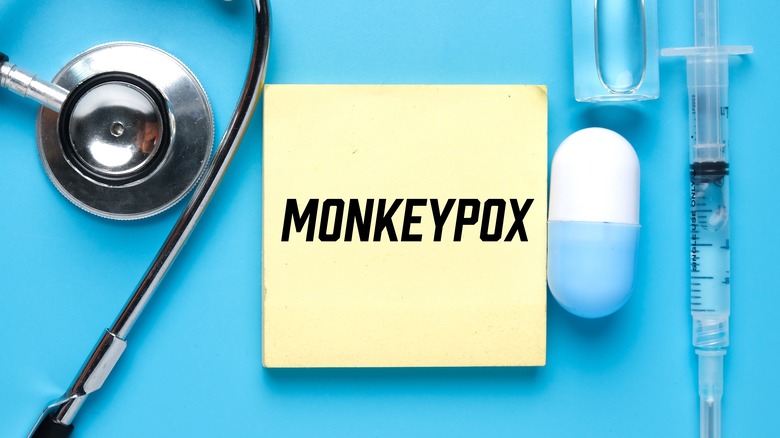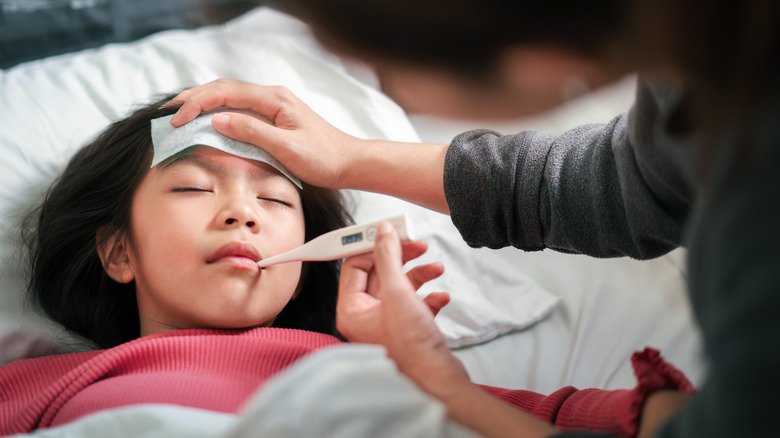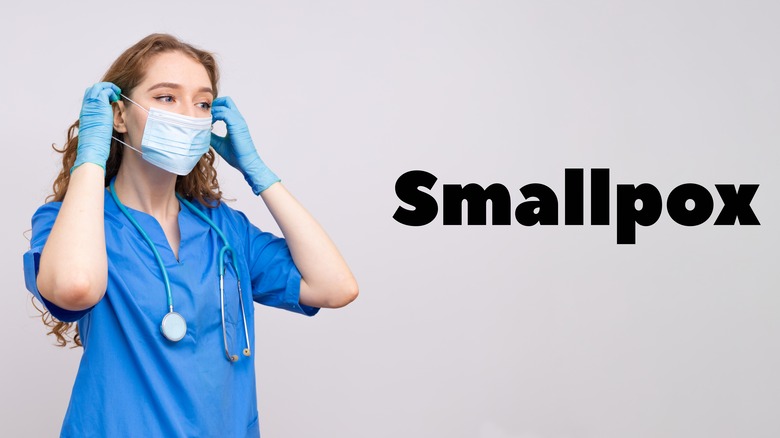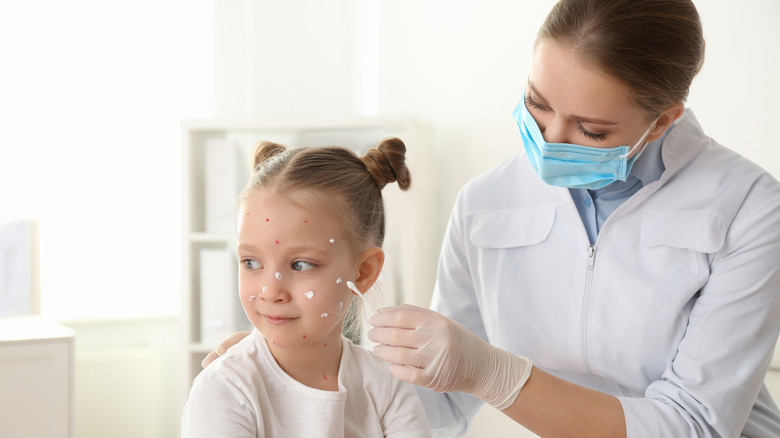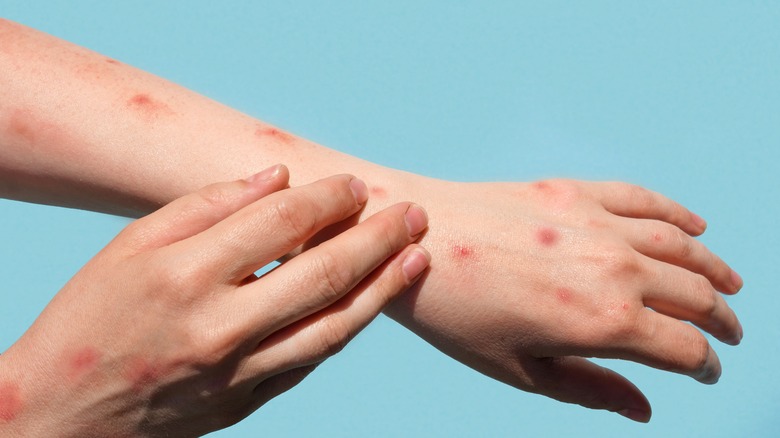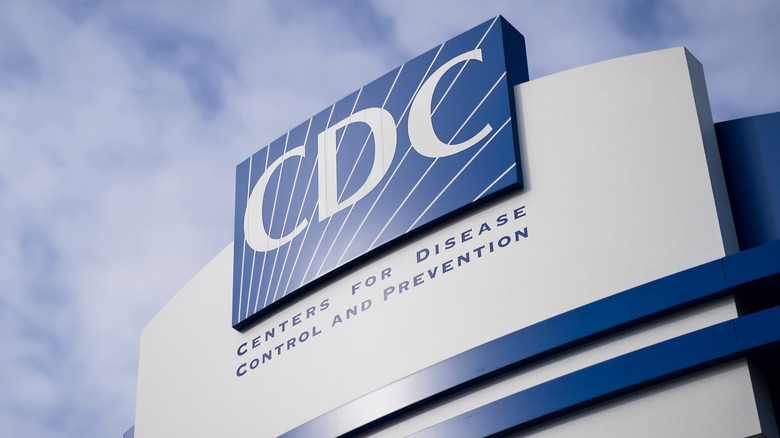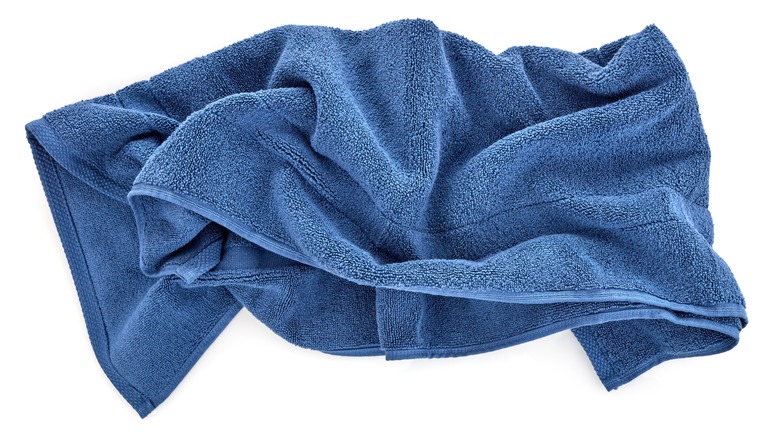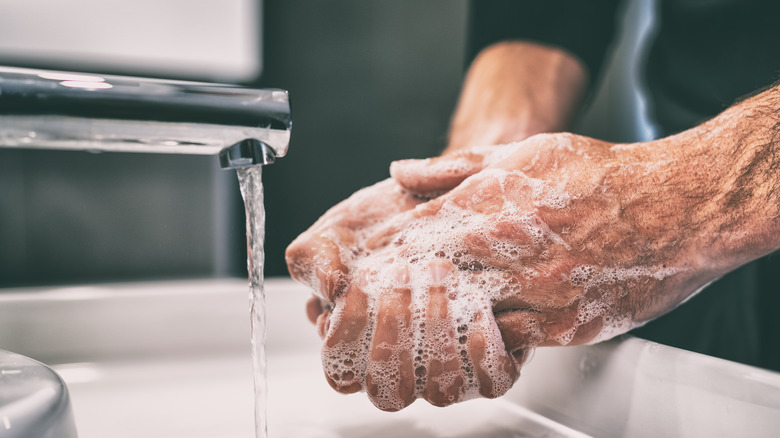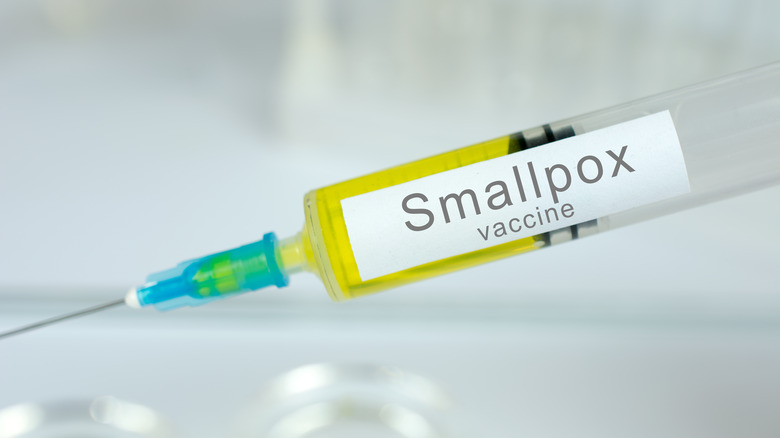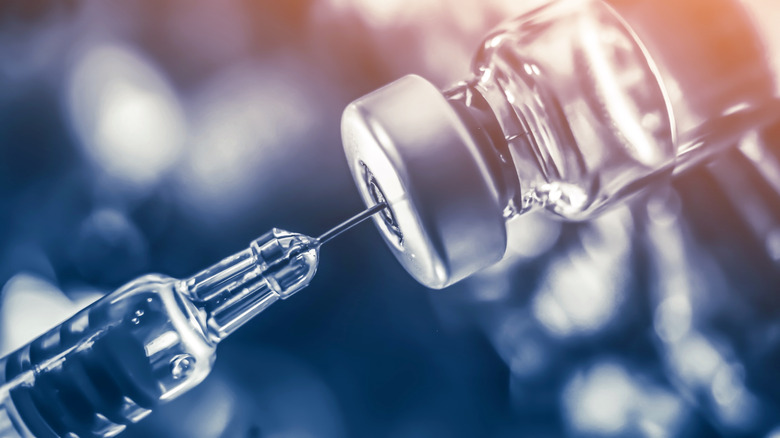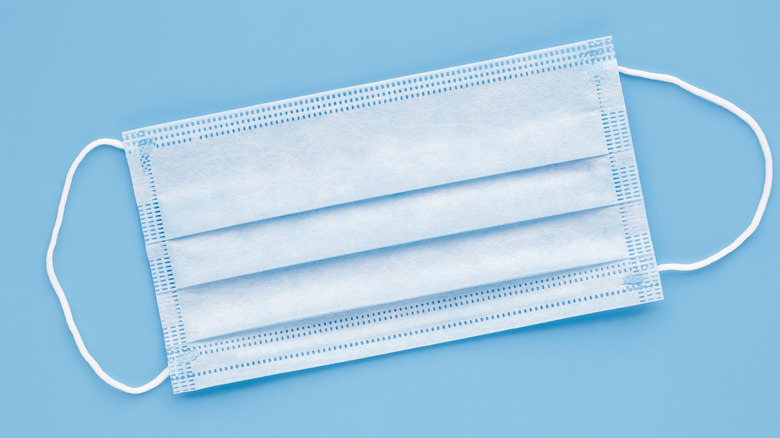Monkeypox Explained: Everything You Need To Know
Chances are if you've been keeping up with world news, you've been hearing about monkeypox. According to reporting from Newsweek, the World Health Organization (WHO) released a document stating that as of late May, 2022, 12 countries so far have reported cases of this viral disease — besides the United States and Canada, these countries are Australia, Belgium, France, Germany, Italy, Netherlands, Portugal, Spain, Sweden, and the United Kingdom. In the U.S., a resident of Massachusetts who visited Canada later tested positive (via NPR).
At this time, it's not clear what exposure caused these monkeypox cases, via the CDC. Healthcare professionals in the United States are being advised to be on the lookout for symptoms of monkeypox in their patients, especially the rash associated with this disease.
There's little doubt that there will be new information about these monkeypox outbreaks in the weeks ahead. Case numbers are very likely going to change. More countries could report incidences of monkeypox. But even in a fluid story, there is basic information that can help you navigate whatever comes next. This article will explore topics like the history of monkeypox, how it's transmitted, warning signs of the virus, and what you can do to lower your chance of contracting it.
Symptoms of monkeypox
While monkeypox is associated with a rash, according to Healthline, those lesions are usually not the first sign of this disease. In fact, a person with monkeypox is likely to run a fever before they show any other symptoms. Other initial red flags of monkeypox can include achiness in the back and/or the muscles, headaches, chills, fatigue, and swollen lymph nodes.
So, when could someone develop lesions from monkeypox? Well, as Healthline explains, that can happen anywhere from one to three days following a fever. But even then, these bumps don't start out full size. They instead go through stages beginning with being flat and discolored then progressing to being slightly raised. Once they reach a certain size, these lesions fill with fluid, which will start out as clear but then become yellow. Finally, the lesions become scabs and fall off the body. A monkeypox patient will typically develop lesions on their face, but lesions can also form on the bottoms of their feet, their genitals, and their hands (in particular, on their palms). A person's mouth and eyeballs can also have monkeypox lesions.
The majority of the time, symptoms of monkeypox clear on their own within two to four weeks. But as with most diseases, monkeypox can sometimes cause more serious complications. Since the monkeypox lesion rash can develop on one's eyes, it's not surprising that this disease can lead to an eye infection and vision loss. Other potential health problems like sepsis, brain inflammation, and bronchopneumonia can also happen as a result of monkeypox.
Monkeypox versus smallpox
The monkeypox virus was first discovered and documented in a Danish laboratory in 1958, according to the World Health Organization (WHO). The lab had monkeys for research, which experienced two outbreaks of the disease, via the Centers for Disease Control and Prevention (CDC). And, yes, the fact that the disease was first discovered in colonies of monkeys is where monkeypox gets its name. Fast forward a little over a decade later, and the first recorded case of a person contracting monkeypox occurred in the Democratic Republic of Congo (per WHO). It was also at this time that smallpox was a major concern, and health organizations were working on efforts to eradicate the disease.
Now, before we go any further, let's be clear about one thing. Although smallpox and monkeypox can have similar symptoms, they are not the same disease, via WHO. As the Mayo Clinic explains, the variola virus is the culprit behind smallpox. But while the monkeypox virus and the variola virus are in the same virus genus (per the National Foundation for Infectious Diseases), they are different viruses. And what's more, there are differences between how they affect those they infect.
WHO notes, for example, that the monkeypox virus typically incubates for six to 13 days (although it can incubate for anywhere from five to 21 days). Smallpox, on the other hand, usually incubates for 17 days (via Mayo Clinic). In addition, while both monkeypox and smallpox can have similar symptoms, monkeypox tends to be less severe.
Monkeypox versus chickenpox
When one thinks of monkeypox, another ailment might come to mind: chickenpox. After all, both have an animal and the word "pox" in their names. But the similarities between the two don't stop there.
Okay, before there's any confusion, let's clear one thing up. As the Australian Government Department of Health explains, chickenpox is caused by the varicella-zoster virus, which is a type of herpes virus. So, chickenpox isn't caused by the same virus as monkeypox. With that said, the two health issues do share certain symptoms. According to the Mayo Clinic, chickenpox can also cause fever and general malaise, as does the monkeypox, according to Johns Hopkins. And the bumps that are a hallmark of chickenpox go through similar stages of development as the ones for monkeypox, including becoming filled with fluid and crusting over.
In addition to sharing similar symptoms, monkeypox and chickenpox can both cause a significant complications. Although chickenpox is usually not a severe disease, there have been cases of it that have resulted in death (via Mayo Clinic). Similarly, the strain of monkeypox that is currently in the U.S. is usually not severe or fatal, per Johns Hopkins. However, don't let those statistics deter you from seeking medical help if you or someone you know has, is showing symptoms of, or might have been exposed to either of these diseases.
Does monkeypox cause scarring?
With a disease like monkeypox that causes lesions, you may wonder if the rash will leave scars. The short answer is, sometimes. According to MedicineNet, it typically takes 14 to 21 days for monkeypox lesions to go away. But remember, the final stages of these lesions' development are scabbing over and falling off, which is why they can cause scars.
As the Cleveland Clinic explains, there are three main layers to one's skin: the epidermis, the dermis, and the hypodermis. When something injuries the dermis, that can lead to scarring (via WebMD). Now, there are various types of scars in terms of appearance, and one type is scars that look like pits or dips. This form of scar is what can happen with monkeypox, since the lesions can destroy oil glands located in the skin, per MedicineNet. Now, unfortunately, once someone has a scar, it never completely goes away. But that doesn't mean a scar can't fade a bit on its own (via Healthline).
In addition to scars becoming less noticeable over time, there are various treatments that might help reduce the appearance of scarring in general, according to WebMD. These include steroid injections, surgery, laser resurfacing, microneedling, and filler injections. Applying products like cocoa butter cream and/or vitamin E to the scar might also make it less noticeable. However, depending on the severity of the scar, you might want to speak with a healthcare professional like a dermatologist to explore your best options.
The U.S. had a monkeypox outbreak in 2003
While monkeypox has been making the headlines recently, this is not the first outbreak of this disease to hit the United States. According to The Journal of Infectious Diseases, back in 2003, there were several dozen cases of monkeypox in the U.S. The BBC noted that there were no fatalities as a result of this outbreak.
So, what was the source of the 2003 United States monkeypox outbreak? Well, as the BBC explained, the carriers of the virus were prairie dogs. But there's a bit more to the story. Business Insider reported that the CDC found that a distributor in Illinois purchased the prairie dogs from a business that shipped the animals with other types of rodents that were infected with the monkeypox virus. This meant that even if the prairie dogs were virus-free prior to shipping, they were exposed to the virus while en route.
Monkeypox spread from close contact, so once an animal is infected, it can pass that infection onto another animal or a human who could unknowingly infect someone else. And in the case of the 2003 outbreaks, Business Insider reported that places like wild animal trade centers, pet stores, and swap meets were all cited by the CDC as potential locations where people may have come in contact with a monkeypox-infected prairie dog.
Can a pet get monkeypox?
Since exposure to prairie dogs infected people with monkeypox in the U.S. back in 2003, does that mean other mammals that are common in the United States could get monkeypox? Well, according to the State of New Jersey Department of Agriculture, there are no reported cases of either dogs or cats contracting monkeypox. However, we're still learning about monkeypox, so we cannot say at this time that it's impossible for members of the canine or feline family to become infected by this disease. And there's one animal that is commonly kept as a pet that can get monkeypox.
So, let's address the obvious first. As its name suggests, members of the primate family like cynomolgus monkeys, squirrel monkeys, and owl-faced monkeys can contract monkeypox. So can gorillas, chimpanzees, baboons, and orangutans. However, rodents like the aforementioned prairie dogs, as well as squirrels, mice, and rats, can all be infected by this disease. As can an animal found both in the wild and as pets: the rabbit.
There are a number of telltale signs if a rabbit or a member of the rodent family comes down with monkeypox. These include coughing, fever, nasal discharge, lethargy, losing patches of hair, and conjunctivitis. And like humans, rodents and rabbits can develop rashes because of monkeypox.
Recent U.S. cases of monkeypox
As of this writing, there are current monkeypox cases being reported in North America, but the U.S. also saw some cases in 2021. As the The New York Times reported in July 2021, a resident of Dallas, Texas, contracted the disease during a trip to Nigeria. The CDC determined that the mask requirements in place because of COVID at airports in Atlanta and Dallas helped to reduce the risk of the Dallas resident spreading monkeypox to others. Nevertheless, the CDC, along with local health officials and an airline (the name of which was not disclosed), contacted passengers who flew with the Texas resident.
Roughly five months after the Texas resident contracted monkeypox, a resident of Maryland also became infected with monkeypox after traveling to Nigeria (via the Maryland Department of Health). The individual exhibited mild symptoms and didn't require hospitalization, but was isolated. "Public health authorities have identified and continue to follow up with those who may have been in contact with the diagnosed individual," said MDH Deputy Secretary for Public Health Dr. Jinlene Chan, adding that the Maryland Department of Health worked in coordination with the CDC.
Can you get monkeypox from another person?
Although a human catching monkeypox from another human isn't extremely common (especially when compared to transmission from animals to humans), that doesn't mean it doesn't happen (via Time). As the CDC explains, someone can contract this disease if the monkeypox virus gets inside someone's body through one of three ways.
First, the virus can get in through breaks in one's skin (via CDC). So, for example, if you were to touch a monkeypox lesion on someone, you could catch the disease, per Time. Body fluids can also contain the monkeypox virus. Second, it can enter mucous members such as in the mouth, eyes, and nose. So, if someone with monkeypox uses a towel, and a person without monkeypox uses the same towel on their face, that person could contract monkeypox. And third, the monkeypox virus can invade someone's body through their respiratory tract. However, as Time points out, it typically takes "prolonged face-to-face contact" to pass along the virus. With that said, sneezing in someone's face can infect them with monkeypox.
Additionally, CNBC reported that Andy Seale — who advises the World Health Organization on different sexually transmitted diseases — said regarding Monkeypox and sexual contact, "Many diseases can be spread through sexual contact. You could get a cough or a cold through sexual contact, but it doesn't mean that it's a sexually transmitted disease."
Air travel and monkeypox
Since it is possible to get monkeypox from another person, how big a risk is it to be in an enclosed area with someone infected with monkeypox? Well, as Fortune reported, the U.K. Health Security Agency (UKHSA) released a document that ranked the risk levels of different forms of human contact and contracting Monkeypox. And one of the areas the document covered is air travel.
According to UKHSA, sitting right next to someone who is infected with monkeypox (like one might on a plane) without wearing personal protective equipment (PPE) is a "medium risk" activity. To give you a comparison, the same document cites touching an infected person's skin, nose, or mouth as a "high risk" activity. Also, UKHSA explained that PPE for monkeypox involves not just a FFP3 mask but also eye protection, gloves, and a gown with long sleeves.
Okay, but what if you're not directly next to a monkeypox patient but still on the same flight as them? Well, the UKHSA document says that if you sit within three rows of the patient, there's still a risk, but it's categorized as low risk, per Fortune. However, according to Fortune, the CDC is monitoring six passengers on a flight who were within three rows of a person carrying the monkeypox virus. The bottom line is that you might want to speak with a healthcare professional about taking precautions while traveling.
How to lower your chances of getting monkeypox
Monkeypox is most often spread via animals to humans, although it can also be spread by humans to other humans (via Cleveland Clinic). One way that a host animal can spread the virus is by biting or scratching. Depending on how it's prepared, eating the meat of an animal infected with monkeypox could also result in contracting the disease (per World Health Organization). Handling the blood or body fluids of a monkeypox-infected animal or human can result in getting monkeypox, as can touching monkeypox lesions. And it's possible to catch the disease through the respiratory tract or by handling items like clothing that are contaminated.
With all this mind, the Cleveland Clinic has some tips for reducing the chances of exposing yourself to the virus that causes monkeypox. These include not having direct contact with animals (alive or dead) and humans who have the disease or might have the disease. If you eat meat or other parts of an animal, you should thoroughly cook it. And if you do have contact with an animal with monkeypox, wash your hands thoroughly with soap and water.
In addition, try not to touch anything that might be contaminated with the virus, including bedding. And if you need to be around someone with monkeypox, use personal protective equipment (PPE). Furthermore, being vaccinated for smallpox can lower your risk of contracting monkeypox.
Are there treatments for monkeypox?
Unfortunately, as the CDC explains, there aren't treatments in particular for monkeypox at present. However, that doesn't mean we're completely defenseless. Remember, the smallpox virus (a.k.a. the variola virus) and the monkeypox virus are part of the same virus genus (via the National Foundation for Infectious Diseases). This means that smallpox vaccines can offer some protection against monkeypox.
For example, there is data suggesting the vaccine JYNNEOSTM could be at least 85% effective at preventing monkeypox, per the CDC. Also, known as Imvanex and Imvamune, this vaccine might also reduce the severity of a case of monkeypox even if the patient is given JYNNEOSTM after being exposed to the virus. In addition, ACAM2000, a vaccine used to inoculate people 18 years old and older against smallpox, could under certain circumstances be used to treat those who have already been exposed to the monkeypox virus. However, one thing to keep in mind about ACAM2000 is that it has a live virus.
Besides JYNNEOSTM and ACAM2000, the scientific community is exploring several other potential monkeypox treatments, according to the CDC. These include Tecovirimat (ST-246), which has shown promise in human clinical trials. While more data is needed about Vaccinia Immune Globulin (VIG), it might be a way to prevent someone with a severely weakened immune system from contracting monkeypox after they're exposed to it. And animal and in vitro studies point to Cidofovir and Brincidofovir (CMX001) maybe being effective against monkeypox.
What vaccines are available in the U.S.?
Although being vaccinated for smallpox can help protect someone from contracting monkeypox, smallpox vaccines aren't generally as available as other vaccines in the U.S. According to the Cleveland Clinic, there is a very specific group of people given a smallpox vaccine: those who work in labs with the virus that causes smallpox. However, that doesn't mean it's impossible for anyone else receive a smallpox vaccine.
The U.S. has a Strategic National Stockpile of medications, devices, and supplies, via the U.S. Department of Health and Human Services. These include vaccines, and as Dr. Jennifer McQuiston, the deputy director of the Division of High Consequence Pathogens and Pathology within the CDC's National Center for Emerging and Zoonotic Infectious Diseases, told CNN regarding Monkeypox, the U.S. had been anticipating needing smallpox vaccines in case of smallpox cases. She said, "I can report that there has been a request for release of the Jynneos vaccine from the National Stockpile for some of the high-risk contacts of some of the early patients." In addition, Dr. McQuinston told CNN that there are more than 1,000 doses of JYNNEOSTM available, and said "we expect that level to ramp up very quickly in the coming weeks as the company provides more doses to us."
Additionally, Dr. McQuinston told CNN that the U.S. also has more than 100 million doses of ACAM2000, another smallpox vaccine. However, as Dr. McQuinston noted, ACAM2000 could have "significant side effects."
Isolating a monkeypox patient
There's no denying that if you suspect you or someone you know has monkeypox, you should seek medical help immediately. And if the diagnosis is positive for this disease, then hospitalization might be required. However, as the CDC explains, a medical professional might determine that some monkeypox patients can remain in their homes for the duration of the disease. But even if a person with monkeypox doesn't go to the hospital, they still need to take precautions.
According to the CDC, a person with monkeypox should avoid contact with animals (both wild and domestic) and avoid leaving their home. If an infected person has a large number of lesions they cannot cover up (the face, in this case, not included) and/or lesions that are leaking fluid, they should be kept separate from others in their home as much as possible. Depending on where the lesions are located, they should wear clothing that covers them to minimize the chances of exposing others to their lesions.
Additionally, monkeypox can affect the respiratory system and lead to symptoms like a sore throat, a runny nose, and coughing, via CDC. If a person has any respiratory-related signs of monkeypox, they should isolate as often as they can from other members of their household. Wearing surgical masks is recommended for both the person infected with monkeypox and the members of their household. Further safety information and isolation guidelines are available on the CDC's website.

